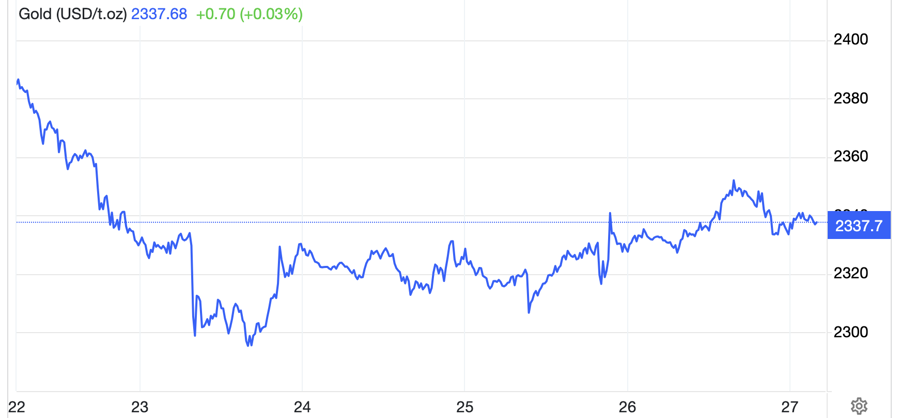Gold Prices Fall Weekly Amidst Reduced Geopolitical Tensions and Inflation Concerns
At the closing bell, spot gold prices in New York City climbed 5.7 USD/oz, marking a 0.24% increase to settle at 2,338.4 USD/oz.
Despite the uptick, gold prices still recorded a 53.8 USD/oz decline for the week, equivalent to a 2.2% drop, ending a five-week winning streak. This represents gold’s steepest weekly loss since December of last year.
A significant factor driving gold’s price decrease this week was the easing of geopolitical tensions in the Middle East, as the threat of a large-scale war between Israel and Iran appeared to be defused. Additionally, rising inflation data from the United States has sparked concerns that the Federal Reserve may delay interest rate cuts, further weighing on gold prices.
As a non-interest-bearing asset, gold tends to perform poorly in high-interest-rate environments. Moreover, the prospect of sustained higher interest rates has pushed the US dollar and Treasury yields higher, exacerbating the pressure on gold prices.
Nevertheless, gold prices rebounded over the course of Thursday and Friday due to renewed concerns about escalating tensions in the Middle East.
Israeli Prime Minister Benjamin Netanyahu stated that any ruling by the International Criminal Court (ICC) – which is investigating both Hamas’ missile attacks on Israel and Israel’s military offensive in Gaza on October 7 – would not affect Israel’s actions but would “set a dangerous precedent.”
Israel has intensified airstrikes on Rafah, after declaring civilians to evacuate from the southern Gaza city and threatening a full-scale ground invasion, despite warnings from allies that such a move could result in major casualties.
This uptick in gold prices occurred despite higher-than-expected inflation data.
According to the US Commerce Department, the core Personal Consumption Expenditures (PCE) index rose by 2.8% year-over-year in March, exceeding economists’ forecast of a 2.7% increase in a Dow Jones poll. Personal spending rose by 0.8%, above the projected 0.7% gain.
The core PCE index is the Federal Reserve’s preferred measure of inflation when making monetary policy decisions based on economic data. On Thursday, the Commerce Department’s first-quarter gross domestic product (GDP) report also showed that core PCE accelerated compared to the previous quarter.
The Fed is set to hold its scheduled two-day policy meeting next Tuesday and Wednesday. No change in interest rates is anticipated at this gathering. Investors are still betting on the Fed starting to cut rates by September.
“The PCE data suggest that inflation could be stickier, but the gold price reaction today suggests that the market has fully priced in concerns about a longer period of higher rates,” said Tai Wong, a precious metals trader in New York.
According to Wong, the future path of gold prices “depends on investors’ risk appetite and physical gold demand in Asia. I think gold in the near term will be range-bound, between $2,300 and $2,400.”

The world’s largest gold ETF, SPDR Gold Trust, sold 2.6 tons of gold on Friday, reducing its holdings to 832.2 tons. For the week, the fund purchased approximately 0.8 tons of gold.
The China Gold Association reported a 6% year-over-year increase in the country’s gold consumption during the first quarter of this year.
Commerzbank remains pessimistic about gold’s price prospects in a rising-rate environment. “Gold has been a little bit softer recently on a stronger tone from the US. If the market starts to price in a deeper path of higher rates, gold could come under more pressure,” the Commerzbank report stated.
The Dollar Index closed Friday’s session with a gain of nearly 0.5%, reaching 106.1, close to the five-month high set earlier in the week. However, the index ended the week roughly unchanged from the previous week’s close.
In Vietnam, the USD exchange rate at Vietcombank closed the week at 25,088 VND (buying) and 25,458 VND (selling), a decrease of 30 VND and unchanged from Friday morning. For the week, USD prices at Vietcombank declined by 45 VND for buying and 15 VND for selling.
Ahead of the upcoming five-day May Day holiday from April 30th to May 1st, SJC gold bar prices were widely quoted above 83 million VND/tael for buying and above 85 million VND/tael for selling.
In Hanoi, prices for 999.9 pure gold ring products from major enterprises such as Phu Quy and Bao Tin Minh Chau fluctuated around 74.7 million VND/tael for buying and 76.4 million VND/tael for selling.












